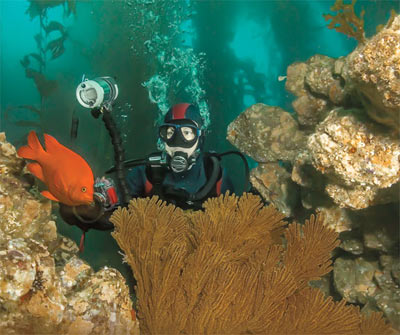Ten Years Ago the California diving community was in the forefront of marine management issues when a group of dive community leaders and representatives negotiated with the Department of Fish and Game (DFG), the Fish and Game (F&G) Commission, and the California Legislature. The result of those efforts resulted in the emergency closure of the commercial and recreational harvest of abalone south of San Francisco and the Farallon Islands. This action by the F&G Commission was unprecedented; it was the first time a user group had gone to managers and asked for curtailment of harvest rights.
At the same time, another group of divers was tasked with finding a legislative solution to a recurring problem with the fishery in decline. They were successful in having (then) Senator Michael Thompson carry a bill which was ultimately passed as SB 463. The bill codified the regional closures we have today, established a voluntary self-tax in the form of the Abalone Stamp and Report Cards which have raised almost $5 million for research, enforcement, DFG oversight and a lot of biology. In exchange, neither the recreational nor the commercial abalone fisheries were to reopen until there had been a demonstrated recovery of all species over the entire southern range to levels specified in a to-be-developed management and recovery plan or ARMP which you can read about at www.dfg.ca.gov/mrd/abalone.html.
We knew the abalone were so far gone that it would be decades before they recovered. We voluntarily surrendered harvest rights for the sake of the resource, provided millions of dollars for research, enforcement and protection of the North Coast abalone resource and partially underwrote the management plan for the recovery efforts. On the other side, about 110 people involved in the commercial abalone industry suffered a partial loss in income from the abalone harvest.
Now, those same displaced businessmen (virtually all of which fish multiple species and have not taken abs for 10 years) are working with the currently appointed group of F&G Commissioners to investigate reopening a commercial fishery at San Miguel Island (SMI) and allow fishing the resource prior to an area wide recovery of abalone populations in the rest of southern California.
The proposal, found as Option #8 of the Abalone Recovery and Management Plan (ARMP), would establish a Total Allowable Catch fishery with a yearly allocation of 15,000 Red Abalone to the commercials and 3,000 to the recreational community. To make a rough analogy of the impact of such a yearly quota, in northern California, densities of 7,500 animals per hectare (10,000 square meters or about 2.47 acres) are considered excellent. The average density at San Miguel is nowhere near 7,500, but there are small expanses there which have those densities. Hypothetically, confined to a single area a yearly quota of 15,000 removes the functional equivalent of every single abalone in five acres of prime abalone habitat, per year. I believe that we could consider the resource at San Miguel Island a remnant at best, since they are the last vestige of a population south of San Francisco. I am at a loss to understand the logic for the proposal to consider reopening fishing on a recovering, remnant population at this time.
Virtually every diving organization in the state, almost all the recreational fishing clubs, EnvironmentalDefense, NRDC, Ocean Coalition and many more groups do not support resumption of fishing by anyone until there has been a recovery to a level supported by science and the DFG. To date there has been no material support for resumption of recreational harvest. Current efforts stem solely from the efforts of a small group of commercial businessmen.
We ask every diver to read the petition at the http://actionstudio.org/?go=2511 and decide if they would like to help with the political contest over the waters we enjoy. We need other dedicated, passionate people to step up and learn how to be effective in defending and protecting our coasts. The long run concern is not just about abalone; virtually every item we see in the kelp forest is food or raw material for something, even the kelp. Who spends more time in the kelp forest than we do?
The Recreational Abalone Advisory Committee (RAAC) was established by statute in 1997. Our function is to make recommendations to the Director of Fish and Game regarding the sport abalone fishery and recovery efforts in southern California. We need to hear from you. We especially need to hear from divers south of Point Conception. Please email your comments to profezzer@hotmail.com or fax them to 949-474-1501 and tell us what you think.
All you ever wanted to know about abalone can be found in the RAAC Meeting Reports at www.dfg.ca.gov/mrd/raac/










